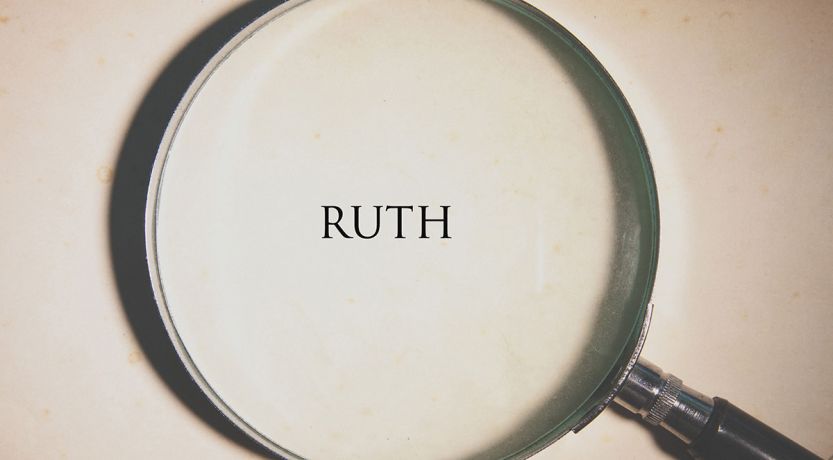Ruth tells the story of the loyal love of an ancestor of David and Jesus Christ. It also reminds us of God’s love, redemption and what is important to Him.

The story of Ruth offers vital lessons to every generation and has enjoyed nearly universal acceptance by biblical scholars and critics throughout the centuries. All seem to be captured by its timeless message of faith, personal sacrifice and the deeper issues of life and human fulfillment.
What is it about this story that has inspired people throughout history? Let’s look into the pages of this book and see what we can learn from a very remarkable woman for all ages.
Who wrote the book of Ruth?
“Jewish tradition in the Talmud accepted Samuel as the author of the book of Ruth” (Zondervan NIV Bible Commentary, Vol. 1, 1994, p. 368).
Most conservative authorities accept the prophet Samuel as the probable author of Ruth. Samuel was the one who anointed David to be king (1 Samuel 16:13), so he could have been knowledgeable of the stories of David’s ancestors.
Historical background of the book of Ruth
Events in this book occur during the time of the judges in Israel (Ruth 1:1), probably in the 12th century B.C., perhaps 50 to 100 years before the birth of David. It was a time of great instability and trouble in Israel, with everyone doing what was right in his own eyes (Judges 21:25).
The setting of the book is the spring barley harvest, hence its long association with the festival of Pentecost, which pictured this early harvest. Ruth is one of the five Festival Scrolls, also known as the Megilloth, in the Writings section of the Old Testament. (The other Festival Scrolls are Song of Songs, Lamentations, Ecclesiastes and Esther.)
Although there was strife, evil and lawlessness generally throughout the time of the judges, the story of Ruth offers us an insight into how the blessings and guidance of God can be bestowed even in difficult times. Ruth, as we shall see, committed her life to helping others; and as a result, she was blessed by God for her faithfulness.
Outline of the book of Ruth
1:1-5: Elimelech and his family go to Moab.
1:6-22: Widowed Naomi and her daughter-in-law Ruth return to Bethlehem.
2: Ruth wins Boaz’s admiration and protection.
3: Ruth appeals to Boaz to be the kinsman-redeemer.
4: Boaz accepts and marries Ruth; they become the ancestors of David and Jesus Christ.
Quotes about Ruth
Before we look at the story, consider a few comments about the impact this book has had through the years.
The Five Megilloth, a Jewish commentary, said, “In style it is matchless: fresh, simple and graceful. The spell of the book is altogether irresistible, for it lies in the heroine whose name it bears; and the chief charm of Ruth herself is her unselfish and devoted love of all that is finest in the physical and spiritual world” (Dr. A. Cohen, p. 36).
The German poet Goethe called it “the loveliest complete work on a small scale ever written” (quoted by Leon Morris in Judges and Ruth, p. 242).
Alexander Schroder, a literary critic, said, “No poet in the world has written a more beautiful short story” (quoted by C.F. Keil and Franz Delitzsch in Biblical Commentary on the Old Testament: Joshua, Judges, Ruth, p. 466).
“The most striking feature of this simple and beautiful story is the sense of God’s intimate concern in humble affairs. He is the One who orders all the circumstances of daily life, even for the most unimportant people” (Eerdmans’ Handbook to the Bible, 1973, p. 226).
Let’s look at the story itself and see just what it is that produced such glowing reviews.
The book of Ruth summary
A man from Bethlehem named Elimelech was forced out of his home by famine and went to live in the land of Moab with his wife, Naomi, and two sons. He died and subsequently his sons married women from Moab, Orpah and Ruth. After 10 years the two sons also died, leaving Naomi and her two daughters-in-law as widows.
Naomi heard that the famine was over in Judea and decided to return to Bethlehem. She urged her daughters-in-law to remain in Moab and find husbands from among their own people. Orpah finally decided to stay, but Ruth was determined to go with Naomi. Again, Naomi urged her to return to her people and her gods.
But it seems Naomi had been faithful to God even while living among the pagan Moabites, and her example of faithfulness had a direct impact on Ruth. Ruth chose to be kind and loyal to her mother-in-law and to commit to her God—the true God.
So Ruth replied to Naomi with the most famous lines from the book: “Entreat me not to leave you, or to turn back from following after you; for wherever you go, I will go; and wherever you lodge, I will lodge; your people shall be my people, and your God, my God. Where you die, I will die, and there will I be buried. The LORD do so to me, and more also, if anything but death parts you and me” (Ruth 1:16-17).
The two women arrived in Bethlehem just in time for the early spring harvest. Ruth immediately went to work in the fields to support herself and her mother-in-law.
Story of Ruth and Boaz
While working in the fields she was noticed by Boaz, a wealthy landowner, who also happened to be related to the family of Naomi’s husband.
Boaz was deeply impressed by this industrious and devoted young widow working in his fields and introduced himself. He told her:
“It has been fully reported to me, all that you have done for your mother-in-law since the death of your husband, and how you have left your father and your mother and the land of your birth, and have come to a people whom you did not know before. The LORD repay your work, and a full reward be given you by the LORD God of Israel, under whose wings you have come for refuge” (Ruth 2:11-12).
The relationship developed further, and God used Boaz himself to fulfill this blessing as the redeemer (which serves as a type of the work of the Messiah). After satisfying some of the technicalities of the ancient laws concerning widows and inheritance, Boaz and Ruth wed.
We may at times think that God is only watching the really important people of this world, but the story of Ruth tells us otherwise. God is not impressed with our wealth, fame or power. He is most impressed with the quality of our character.
This marriage was one of the most significant in Jewish history because the great-grandson of Boaz and Ruth was none other than the most famous and loved ruler of Israel, King David (Ruth 4:21-22). This also means Ruth was in the line of the Messiah, Jesus Christ (Matthew 1:1, 5).
Themes of the book Ruth
Two key concepts in the book of Ruth can shed light on the themes of the book.
Loyal love
Loyal love is an important theme of the book (Hebrew hesed or checed; translated “kindly” and “kindness” in Ruth 1:8; 2:20; and 3:10).
“The important idea of loyal love is evident in the book. The Hebrew word translated as kindly in 1:8 means ‘loyal love’ or ‘covenantal love.’ This was a genuine love that keeps promises. When the word is used of God, it refers to God’s loving faithfulness to His promises. Even though Ruth was a foreigner and was not familiar with God’s law, she displayed this type of love and loyalty to her mother-in-law Naomi . . . Boaz also showed the same noble quality by protecting and providing for Ruth, a widow of one of his relatives.
“Yet the story of Ruth ultimately illustrates how God Himself demonstrated such love. He rewarded Ruth for her loyalty to Him by giving her an honored place in the community of faith. He blessed her with a child who would become the ancestor of King David and later of the promised Messiah” (NKJV Study Bible, introduction to Ruth).
Redemption
The kinsman-redeemer (Hebrew goel; “close relative” in Ruth 3:9) highlights the theme of redemption. In many ways, Boaz’s redeeming Ruth was a type of the redemption provided by Jesus Christ.
“The kinsman-redeemer was ‘the defender of family rights.’ This individual was a close relative who had the financial resources to rescue a poverty-stricken family member, stepping in to save that relative from slavery or from having to sell the family’s ancestral land. In the story of Ruth, Boaz redeemed the land that Naomi was about to sell. He also took on another of the kinsman-redeemer’s responsibilities—the obligation of providing an heir for Ruth’s deceased husband, Mahlon . . .
“Boaz willingly took on this duty, even though he was not the nearest relative (3:12, 13). He bought the land from Naomi, married Ruth, and carried on the family name through the birth of their son. Through all these actions, Boaz exemplified the compassion and love of a redeemer. His life is an illustration for us of the compassion of Jesus, who is our Redeemer (Gal. 3:13)” (NKJV Study Bible, introduction to Ruth).
Spiritual lessons from the book of Ruth
1. God notices people of good character.
God’s presence in the book of Ruth is felt in the “chance” meeting of Boaz and Ruth. Did she really just happen by accident to go to work in his fields? Did he just happen to see her working and discover that he was related to Naomi’s family? Did the events leading to this marriage all just work out by chance?
It seems clear to all who have studied the events of this book closely that God was taken by the character of this devoted, faithful young widow who was willing to put others’ needs before her own. The unseen hand of God was at work to bring all these things to pass, especially when we consider that King David and Jesus Christ Himself descended from this special woman.
This story fully supports the biblical truth written by the prophet Isaiah that God looks to those people who are poor and of a contrite spirit and tremble at His words (Isaiah 66:2).
In the midst of all that was happening in the world of the 12th century B.C., the attention of our great God was caught by a quiet, young widow, working in the fields. We may at times think that God is only watching the really important people of this world, but the story of Ruth tells us otherwise. God is not impressed with our wealth, fame or power. He is most impressed with the quality of our character.
As God told Samuel when he was searching for the one to anoint as king, “Do not look at his appearance or at his physical stature, because I have refused him. For the LORD does not see as man sees; for man looks at the outward appearance, but the LORD looks on the heart” (1 Samuel 16:7). In that case, God led Samuel to Ruth’s great-grandson, David, a man after His own heart.
2. All that is good and worthwhile will come to us if we are patient and commit ourselves to doing what is right in the eyes of God.
Ruth was a widow, a foreigner in the land of Judea who had to work hard at menial labor to support herself and an aged mother-in-law. Her choice to do the right thing, helping and supporting Naomi instead of just pleasing herself, brought God’s blessings to her.
In this day of instant gratification, it is good to be reminded of this timeless lesson about the way to find real happiness and fulfillment. The apostle Paul supported this view when he wrote that God “will render to each one according to his deeds: eternal life to those who by patient continuance in doing good seek for glory, honor and immortality” (Romans 2:6-7, emphasis added throughout).
Paul also wrote, “And let us not grow weary while doing good, for in due season we shall reap if we do not lose heart” (Galatians 6:9). The fullness of God’s blessings may not come in this life, but the ultimate glory He has in store for us is beyond what we can humanly imagine (1 Corinthians 2:9).
Moral of the story of Ruth in the Bible
Right now, in the homes of seemingly unimportant people who are living and dying with little public awareness, God may be fully engaged in shaping the future history of the world. God looks deep inside all people. He is taken not by the size of their bank accounts, popularity, authority or intellect, but by the quality of their character, just like He was with Ruth.
This is a powerful moral of the story we can learn from this remarkable woman. Read the book of Ruth. Imitate her conduct. Find real meaning for your life.
Read more about Ruth and her example of faithfulness in our “Women of Faith” series article about “Ruth.”
For a quick link to all the other books of the Bible, see “Books of the Bible” on the Learning Center.





